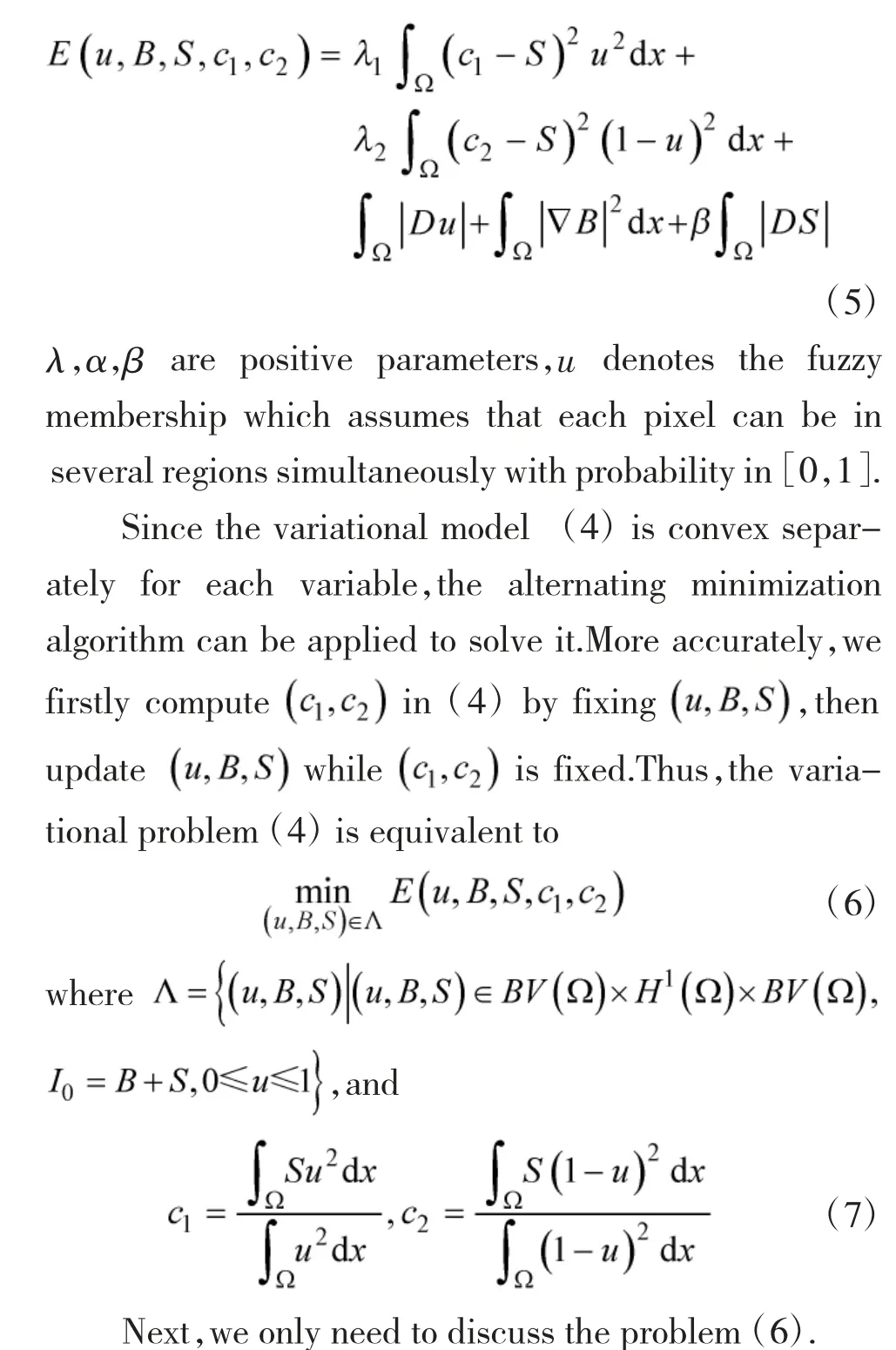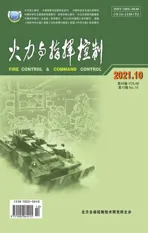A Fuzzy Cluster and Retinex Theory-based Variation Model for Inhomogenous Image Segmentation
2021-12-29SUNMengxuanLUOQunnvMINLihuaFENGCan
SUN Meng-xuan,LUO Qun-nv,MIN Li-hua,FENG Can
(1.Msc-erlectronic and Electrical Engineering,Durham University,Durham,UK;2.School of Science,Nanjing University of Posts and Telecommunications,Nanjing,China;3.North Information Control Research Academy Group Co.,ltd.,Nanjing,China)
Abstract:A variational inhomogeneous image segmentation model based on fuzzy membership functions and Retinex theory is proposed by introducing the fuzzy membership function.The existence of the solution of the proposed model is proved theoretically.A valid algorithm is designed to make numerical solution of the model under the framework of alternating minimization.The last experimental results show that the model can make segmentation of the real image with intensity inhomogeneity effectively.
Key words:image segmentation,intensity inhomogeneity,fuzzy membership,Retinex theory,alternating minimization
0 Introduction
Image segmentation plays an important role in image analysis and computer vision.Segmentation is a process of partitioning an image into meaningful regions which are homogeneous with respect to their features such as intensities,textures,colors and so on.However,due to incomplete imaging devices and effects by the illumination variations,intensity inhomogeneity inevitably occurs in real-world images,which poses a severe challenge to image segmentation methods.
After years of development of image segmentation technology,a large number of research methods and achievements have emerged,such as methods based on variational and partial differential equations.These methods can be divided into two main categories:edgebased and region-based approaches.The edge-based methods usually use gradient information to guide the evolving contour to move toward the object boundary[1-3].These methods can generate some good segmentation effects,but there still exist a few drawbacks,such as sensitivity to noise,and initial contours and inability to extract the objects with blurred or weak boundaries.The region-based methods use region information for guidence the evolution of contour.One of the most famous region-based variational models is the MS model[4],which aims to find an optimal piecewise smooth function to approximate the original image.Although this model can achieve good segmentation results,it is more complex in calculation.In[5],a first variation of the MS model was proposed by Chan and Vese(CV).The model regards the gray values of different regions in the image as the corresponding piecewise constants and can effective segment the intensity homegenous image.Like the CV model,those segmentation models[6-7]based on the assumption of intensity homogeneity are not sufficient to segment inhomogeneous images.
In the past thirty years,fuzzy segmentation methods[8-16]have been widely developed,especially the fuzzy c-means clustering method.The advantage of the method is mainly the introduction of fuzziness for the belongingness of each image pixel.This enables the clustering methods to retain more information from the original image.Ahmed et al.[16]modified the objective function of the standard FCM algorithm to compensate for intensity inhomogeneity and to allow the labeling of a pixel to be influenced by the labels in its immediate neighborhood.In Reference[17],the author proposed a coherent local intensity clustering (CLIC)algorithm based on intensity information in local regions for the bias field estimation and image segmentation.Subsequently,Li et al.[18]developed a variational fuzzy MS model for image segmentation with inhomogeneous intensity,and then used operator splitting method to solve the minimization problem about membership function.In addition,the fuzzy logic has been intensively used in active contour methods.In[19],Krinidis et al.presented a novel fuzzy energy-based active contour model with a pseudo-level set function.The fuzziness provides the model with a strong ability to reject local minima.Wu et al.[20]proposed a region-based fuzzy active contour model with kernel metric,which is more robust against the noise and outliers in an image.Also,in order to get more desirable segmentation results,the methods integrating local and global intensity information have attracted more attentions,see[21-23]for instance.
In recent years,many scholars have also proposed some Retinex theory-based segmentation approaches[24-27].In 2017,Zosso et al.[24]proposed a CV-B model by integrating Retinex theory into CV model.Later,on the basis of CV-B model,Jin et al.[26]proposed a new variational model,called Jin’s model for segmenting inhomogeneous images.They took into account the piecewise constant property of structure part and introduced the total variation term into CV-B model to correct and segment the input image and the relative accurate segmentation results can be obtained.Very recently,Min et al.[27]proposed an inhomogeneous image segmentation model which considers simultaneously the local constant and global smoothness priors of the bias part.So,it can obtain more accurate segmentation results.
In this paper,the Jin’s model is improved and propose a new variational segmentation model based on fuzzy cluster and Retinex theory.The existence of solution of the proposed variational model.Also,under the framework of alternating minimization method an effective algorithm is designed to make numerical solution of the model.The final experimental results show that the proposed model can effectively segment real images with intensity inhomogeneities.Compared with the existing Cai’s model[6],Yang’s model[7]and Jin’s model[26],it can obtain more accurate segmentation results.
The subsequent section is structured as follows.In Section 2,a new variational model for image segmentation is proposed and the theoretical results of the model is proved and the fast solution algorithm of the model is designed.In Section 3,experimental results and comparisons are presented to verify the effectiveness and feasiblity of the proposed method.In Section 4,the conclusion summarizes the main work of the paper.
1 Variational segmentation method
Based on the Retinex theory[26-27],the observed image i is modeled as follows:

where b is spatially smooth illuminance(bias)component and s is piecewise constant reflectance(structure)component.In order to handle the product form,we take the logarithmic transform for both sides of formulation(1)

By introducing the fuzzy membership function,we propose the following variational model on the basis of Jin’s model.Specifically,the variational problem can be expressed as

where the functional

1.1 Theoretical analysis
Following the idea of the reference[26],we can prove the existence of the minimizers to the variational problem(6).So,only the differences are given here.


1.2 The alternating minimization algorithm



The corresponding Euler-Lagrange equation is

Based on the above results,the detailed steps the algorithm is as follows.
1) Enter an image i,linearly extend i to the interval[0,1]and take logarithm on i:I0=log(i+1).




2 Numerical experiments
In this section,the synthetic images and real images are experimented by comparing the performance of the proposed method with Cai’s model,Yang’s model and Jin’smodel.The segmentation performance of the model on t he intensity inhomegeneous images is verified.We obtain their experimental results by applying the default settings and tune the parameters of each image to provide the best possible results.In all experiments,we set λ1=λ2and choose most parameters as the default values:β=3,ρ2=0.5,ε=10-4.The parameter α is adjusted according to the intensity of bias.The detailed values of the parameters λ1,λ2,α,ρ,ρ1are listed in Table 1 for different test images.The running environment of the experiment is:CPU of PC is AMD Ryzen 5 4600U,the operation system is 64 bit win 10.The version of Matlab is R2020b.

Table 1 Parameters settings for images I-XI of the proposed model
Quantitatively,we evaluate the quality of image segmentation by Dice similarity coefficient(DSC)[28],Segmentation accuracy (SA)[7],Hausdorff distance(HD)[29].They are defined as

where R1is the segmented object region,R2denotes the relative ground truth of object region,denotes the area.HD is an index of evaluating the segmentation error,which is defined as:

where A is binary image of the segmentation result,A~refers to the corresponding ground truth,n is the total number of target boundary set.Furthermore,SA is defined as:

Obviously,larger DSC and smaller HD mean moreaccurate segmentation results.And the closer SA value is to 1,the better the segmentation is.
2.1 Initial contour robustness experiment
In this subsection,robustness of the method to initialization is demonstrated.Here,we apply our method to the synthetic image (a)in Fig.1 with four different initial contours and test the effects of these contours.Images(a)and(b)are the input image and corresponding ground truth respectively.Four different initial contours are shown in images(c)~(f).In spite of the great differences of these initial contours,the corresponding results shown in images(g)~(j)are almost the same and their HD values are all 0.These results demonstrate the robustness of the proposed methodto contour initialization.

Fig.1 Segmentation results on synthetic image with different initial contour by the proposed method:(a)input image;(b)ground truth;(c)~(f)the initial contour(green boxes)and corresponding results(red curves);(g)~(j)binary images for the segmentation results.
2.2 Two-phase segmentation
Next,we demonstrate the performance of different methods on segmentation of seven natural inhomogeneous images.In Fig.2,seven original images with corresponding initialization is shown in the first column,and the last column are the ground truths.These images can be downloaded fro m the Weizmann segmentation dataset and MSRA 10K dataset with their corresponding ground truth.The segmentation results of the Cai’s model,Yang’s model,Jin’s model and our method are shown from the 2nd to 5th columns respectively,whose final stopping boundaries are marked with red curves.

Fig.2 Two-phase comparison experiments on test images,First column:input images with corresponding initial contours;Second column:Cai’s model;Third column:Yang’s model;Fourth column:Jin’s model;Fifth column:the proposed model;Last column:the ground truths.
It can be seen from image II that the segmentation result of Jin’s model has some incorrect points in the salient object because of large inner gray variation.The results obtained by Cai’s model and Yang’s model have a serious problem of over segmentation.In contrast,the proposed method performs well to segment this image,the curve stops at the edges accurately.From image III,the results of Cai’s model and Yang’s model miss some details of the bird,mainly in the wings.The segmentation results of Jin’s model and the proposed model are not much different and all of them segment the image more precisely.For images IV and V,we observe that Cai’s model,Yang’s model cannot be able to extract the correct object boundary.Also,the first three models have obvious incorrect points in the eyes of the mask for.For image VII,the results of Cai’s model and Jin’s model have some incorrect points in the target object.Yang’s model and the proposed model perform well and get relatively desirable segmentation results.
In order to describe the setgmentation performance of the images with 4 models,we record theDSC,HDand SAvalues of each method on every image in Table 2.It can be seen that the proposed model has the largest values in terms of average Dice coefficient and the lowest mean of HD value.Thus,the experimental results illustrate that our method can successfully extract the object from natural images with intensity inhomogeneity.

Table 2. Evaluation results of comparison experiments on test images in Fig.2.The number in boldface indicates the best results in its column.
2.3 Real images segmentation
Finally,we display the applications of the proposed method to segment real images.We first show four real images in the first column of Fig.3.These images exhibit obvious intensity inhomogeneity.It is found that for Cai’s model and Jin’s model,some incorrect points are generated in the salient object because of large inner gray variation in image IX.For image X,Cai’s model and Yang’s model cannot extract the correct target from the image.By observing the last column,it can be seen that the proposed model can obtain good segmentation results,which indicate the effectiveness of the model for segmenting real images with intensity inhomogeneity.
3 Conclusion
We have presented a new variational model based on fuzzy clustering and Retinex theory for inhomogeneous image segmentation in this paper.Our method can obtain more information from the original images by using the fuzzy membership function,so that the model can acquire more accurate segmentation results.The existence of the minimizers to our variational model hasbee n proved.Moreo ver,under the framework of alternating minimization,we have designed an effective algorithm to numerically solve the model.Numerical experimental results demonstrate our method is robust to initial contour and can achieve more accurate segmentation results than several classical models.The proposed model is verified to get more accurate segmentation precision.

Fig.3Comparison experiments on four real images.First column:input images with corresponding initial contours;Second column:Cai’s model;Third column:Yang’s model;Fourth column:Jin’s model;Fifth column:the proposed model.
4 Acknowledgments
The authors would like to thank Prof.Cai and Prof.Duan for providing the MATLAB codes of[6]and[7],and thank the anonymous reviewers for their valuable suggestions that improve the manuscript
